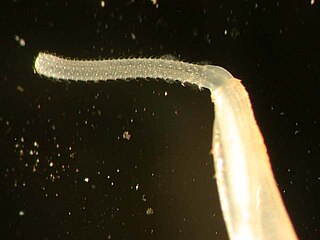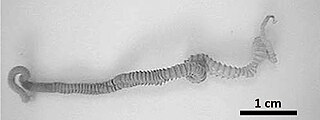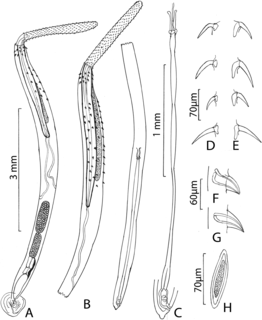
Acanthocephala is a phylum of parasitic worms known as acanthocephalans, thorny-headed worms, or spiny-headed worms, characterized by the presence of an eversible proboscis, armed with spines, which it uses to pierce and hold the gut wall of its host. Acanthocephalans have complex life cycles, involving at least two hosts, which may include invertebrates, fish, amphibians, birds, and mammals. About 1420 species have been described.

Palaeacanthocephala is a class within the phylum Acanthocephala. The adults of these parasitic platyzoans feed mainly on fish, aquatic birds and mammals. This order is characterized by the presence of lateral longitudinal lacunar canals and a double-walled proboscis receptacle. The nuclei of the hypodermis are fragmented and the males have two to seven cement glands, unlike their relatives the Archiacanthocephala which always have eight.
Quadrigyridae is the only family within Gyracanthocephala, an order of parasitic worms of class Eoacanthocephala. This family contains two subfamilies, ten genera and about 92 species.

Polymorphida are an order of thorny-headed worms. The adults of these parasitic platyzoans feed mainly on fish and aquatic birds.

The thorny-headed worm family Polymorphidae contains endoparasites which as adults feed mainly in fish and aquatic birds. When this taxon was erected by Meyer in 1931, a subfamily Polymorphinae was established in it. As the Polymorphidae as presently understood would then be monotypic, with no basal genera outside the Polymorphinae, the proposed subfamily is redundant for the time being and therefore most modern treatments simply omit it. Polymorphus minutus is an economically significant parasite in goose and duck farming.

Profilicollis is a genus of acanthocephalan parasites of crustaceans. The status of the genus Profilicollis has been debated, and species placed in this genus were formerly included in the genus Polymorphus. However, research on the morphology of the group and their use of hosts has concluded that Profilicollis and Polymorphus should be regarded as distinct genera, and species previously described as Polymorphus altmani are now referred to as Profilicollis altmani in taxonomic and biological literature. Profilicollis parasites infect decapod crustaceans, usually shore crabs, as intermediate hosts, and use many species of shorebirds as definitive (final) hosts.
Apororhynchus is a genus of small parasitic spiny-headed worms. It is the only genus in the family Apororhynchidae, which in turn is the only member of the order Apororhynchida. A lack of features commonly found in the phylum Acanthocephala suggests an evolutionary branching from the other three orders of class Archiacanthocephala; however no genetic analysis has been completed to determine the evolutionary relationship between species. The distinguishing features of this order among archiacanthocephalans is a highly enlarged proboscis which contain small hooks. The musculature around the proboscis is also structured differently in this order. This genus contains six species that are distributed globally, being collected sporadically in Hawaii, Europe, North America, South America, and Asia. These worms exclusively parasitize birds by attaching themselves around the cloaca using their hook-covered proboscis. The bird hosts are of different orders, including owls, waders, and passerines. Infestation by an Apororhynchus species may cause enteritis and anemia.
Gigantorhynchida is an order containing a single family, Gigantorhynchidae of parasitic worms that attach themselves to the intestinal wall of terrestrial vertebrates. Gigantorhynchida contains the following two genera:

Gigantorhynchus is a genus of Acanthocephala that parasitize marsupials, anteaters, and possibly baboons by attaching themselves to the intestines using their hook-covered proboscis. Their life cycle includes an egg stage found in host feces, a cystacanth (larval) stage in an intermediate host such as termites, and an adult stage where cystacanths mature in the intestines of the host. This genus is characterized by a cylindrical proboscis with a crown of robust hooks at the apex followed by numerous small hooks on the rest of the proboscis, a long body with pseudosegmentation, filiform lemnisci, and ellipsoid testes. The largest known specimen is the female G. ortizi with a length of around 240 millimetres (9.4 in) and a width of 2 millimetres (0.08 in). Genetic analysis on one species of Gigantorhynchus places it with the related genus Mediorhynchus in the family Gigantorhynchidae. Six species in this genus are distributed across Central and South America and possibly Zimbabwe. Infestation by a Gigantorhynchus species may cause partial obstructions of the intestines, severe lesions of the intestinal wall, and may lead to death.
Mediorhynchus is a genus of small parasitic spiny-headed worms. Phylogenetic analysis has been conducted on two known species of Mediorhynchus and confirmed the placement along with the related genus Gigantorhynchus in the family Gigantorhynchida. The distinguishing features of this order among archiacanthocephalans is a divided proboscis. This genus contains fifty-eight species that are distributed globally. These worms exclusively parasitize birds by attaching themselves around the cloaca using their hook-covered proboscis. The bird hosts are of different orders.

Moniliformidae is a family of parasitic spiny-headed worms. It is the only family in the Moniliformida order and contains three genera: Australiformis containing a single species, Moniliformis containing eighteen species and Promoniliformis containing a single species. Genetic analysis have determined that the clade is monophyletic despite being distributed globally. These worms primarily parasitize mammals, including humans in the case of Moniliformis moniliformis, and occasionally birds by attaching themselves into the intestinal wall using their hook-covered proboscis. The intermediate hosts are mostly cockroaches. The distinguishing features of this order among archiacanthocephalans is the presence of a cylindrical proboscis with long rows of hooks with posteriorly directed roots and proboscis retractor muscles that pierce both the posterior and ventral end or just posterior end of the receptacle. Infestation with Monoliformida species can cause moniliformiasis, an intestinal condition characterized as causing lesions, intestinal distension, perforated ulcers, enteritis, gastritis, crypt hypertrophy, goblet cell hyperplasia, and blockages.

Oligacanthorhynchida is an order containing a single parasitic worm family, Oligacanthorhynchidae, that attach themselves to the intestinal wall of terrestrial vertebrates.

Cavisomidae are a family of parasitic worms from the order Echinorhynchida.
Fessisentis is a genus of parasitic spiny-headed worms. It is the only genus in the family Fessisentidae. This genus contains six species that are distributed across the Eastern continental United States as far west as Oklahoma and Wisconsin. These worms parasitize salamanders and fish.
Polyacanthorhynchidae is a family of parasitic worms from the. It contains a single genus Polyacanthorhynchus.

Rhadinorhynchidae is a family of parasitic worms from the order Echinorhynchida.
Polymorphus is a genus of parasitic worms from the phylum Acanthocephala. This group uses amphipod crustaceans as intermediate hosts and various birds as final hosts.
Acanthocephalus anguillae is a species of parasitic worm in the phylum Acanthocephala. An intestinal parasite, it is found both in the Baltic Sea and along the coast of California, where it is often found in the fore- and mid-gut of the Brown and Rainbow trouts.
Acanthocephalus echigoensis is a species of parasitic worm in the phylum Acanthocephala. Found both in California and in Thailand, it has been known to parasitize the sockeye salmon, chum salmon, rainbow trout, and barramundi.
Filicollis anatis is an endoparasite in the Polymorphidae family of thorny-headed worms. Adults have been found to occur in waterbirds such as ducks, where they cause a condition known as filicollosis. Larval stages occur in invertebrate hosts such as crayfish.







